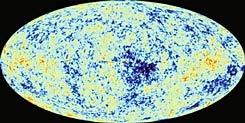Yuval Dror, Haaretz, voila!

An image published by NASA in February 2003, showing the universe in its initial stages of formation
Direct link to this page: https://www.hayadan.org.il/bigbang070904.html
The Big Bang theory is accepted today as the theory that explains the formation of the universe. Although there is a lot of information about the founding event, it is still not clear what happened to all the matter in the universe from the moment of the big bang (13.7 billion years ago) until today. An international group of scientists recently performed the first computer simulation (simulation) of its kind, in which a supercomputer was used, to track the movement of matter in the universe and its transformation into galaxies and stars. The result: 64 "pictures" of the universe at different stages of its life. In the coming weeks, the scientists plan to transfer some of the information to the Internet.
The big bang theory was established in the 20th century, when Edwin Abel discovered that the different galaxies are moving away from each other, and from this he concluded that the universe is expanding. If the universe is expanding, it must have a starting point in space and time, from which the expansion began; The beginning of expansion is called the Big Bang. In recent years, evidence has been collected for the correctness of the theory. One of the evidences is the "Cosmic Background Radiation", which was discovered in 1965 and determined to have been emitted following the Big Bang. And yet, the question arises, how did the matter spread in the universe until it reached its current form?
The group of scientists - known as the Virgo Consortium and consisting of scientists from the USA, Canada, Germany and the UK - began working on the imaging project a few years ago. She asked to plan and implement a computer simulation that shows the way the universe expanded from the time it was about 380 thousand years old until today. The unique project was reported in its latest issue by IEEE Spectrum magazine.
For the simulation, the scientists used a YBM supercomputer, which is ranked 31st in the list of the 500 most powerful supercomputers in the world. It consists of 812 processors, capable of performing 4.2 trillion calculations per second. This enormous computing power is necessary; There are about a hundred billion galaxies in the universe and each of them contains about a hundred billion stars. There is no computer on Earth - and probably won't be in the near future - that is capable of calculating the movement of all these stars in space, over a period of more than 13 billion years.
Therefore, the scientists used "only" 10 billion points to represent the matter scattered in the universe. Each point represented a mass a billion times greater than that of our Sun. The computer must check and calculate how each point behaves in relation to the other 9,999,999,999 points - total calculations: about 100 million trillion (1 and 20 zeros after it). And all this, just for one moment in the history of the universe.
To shorten the process, the scientists divided the 10 billion points into several groups and calculated their group movement. This is how they managed to create 64 "pictures" of the universe that should be available on the Internet in the coming weeks. The problem is, each such image generates a huge collection of information, and in total 20 terabytes (20 thousand gigabytes). Now the scientists are trying to find a method that will allow the reduction of the amount of information so that surfers, even those with fast Internet access, can download it.
This is not the first time that researchers try to create a visualization of the universe. According to Robert Bartz, who is responsible for the field of astrophysics at the Science Museum in Haifa, cosmologists are interested in the Big Bang for several reasons. "First, there is a passion for pure scientific knowledge," he says. "Furthermore, the origin of almost every atom in the human body is in space. In fact, we are made of stardust. Understanding the processes that created the universe and our solar system will help us discover where we came from." Ilan Manolis from the Astronomical Club of Tel Aviv University added: "If we understand how the universe was created and what happened to it from the beginning of the Big Bang until today, we can better predict what will happen to it from here on."
https://www.hayadan.org.il/BuildaGate4/general2/data_card.php?Cat=~~~944492603~~~60&SiteName=hayadan
